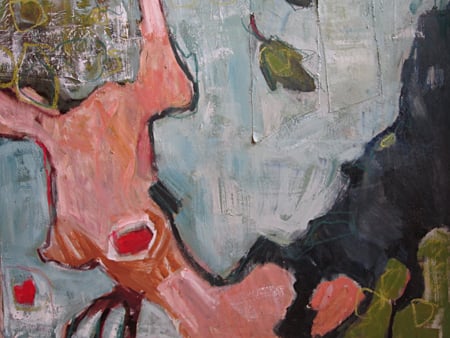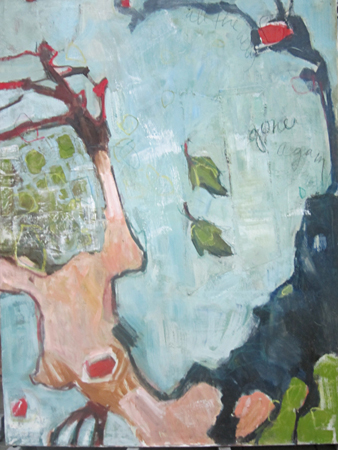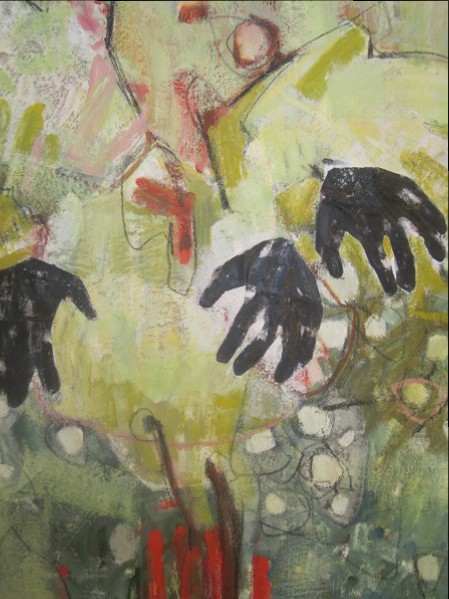Art World
Artist Q&A with Heather Dee Robertson
Learn about Expressionist painter Heather Dee Robertson and her influences and methods.

Learn about Expressionist painter Heather Dee Robertson and her influences and methods.

Rebecca Honts


Heather Dee Robertson, Gone Again, 2011, oil and pastel on canvas
Artist Name: Heather Dee Robertson
Medium: Oil on canvas
Style: Abstract Expressionism
Heather Dee Robertson is an Expressionist painter who lives in Brooklyn, N Y. Born in Maryland to a family of artists, she later attended Virginia Commonwealth University, where she earned a degree in illustration. She now exhibits her paintings in the burgeoning Brooklyn art scene. Robertson also works in design and framing in the Upper West Side, where her oil paintings are featured in the Ostojic Gallery, an extension of Frames for You.

Heather Dee Robertson, (cross section) Gone Again, 2011, oil and pastel on canvas
Rebecca Honts: How would you describe yourself and your work?
Heather Dee Robertson: I am in the midst of a creative journey. At age 30, my work still feels fresh and new to me. I am fortunate to have been exposed to the arts at a very young age, and it didn’t take long before I felt the urge to find my own voice. In the process, I have forced myself to reach beyond the familiar as well as beyond my formal training. It’s not always a clear trajectory, and while branching out experimentally, my early influences have infused themselves into my work. My paintings take on many incarnations, but ultimately I feel my work can now be best described as Abstract Expressionism. Much like Henri Matisse (French, 1869–1954) or Charles Ephraim Burchfield (American, 1893–1967), I see my process as one that transcends form and builds on atmosphere.

Heather Dee Robertson, Fertility, 2012, oil, pastel, and newspaper on canvas
RH: What kind of artistic training do you have?
HDR: My first training happened under my mother, when I participated in her neighborhood art classes. My family was very supportive of my choice to further my education by attending a liberal arts school and majoring in illustration. As time has gone by, I’ve found that this has been both a blessing and a curse. My training has created a need towards narration. I have maintained this to some extent, but my narrative structure has been refocused. In a sense, my background has given me a defining point of departure.

Heather Dee Robertson, Monologue, 2011, oil, pastel, and newspaper on canvas, 2011
RH: Who and/or what are your influences?
HDR: I have had many influences throughout my career. I was exposed and drawn to Vincent Van Gogh (Dutch, 1853–1890) and Winslow Homer (American, 1836–1910) early on, even though they have very different artistic styles; I was attracted to their color palates and to their relationship with nature. I am also captivated by Romanticism, which has made its way into my work. In addition, I’m inspired by poets like Mandelstam and Neruda, who paint themselves into the landscape using only words. I have taken a similar direction in my work. Anselm Kiefer (German, b.1945) stands out as successfully bridging this desire to engage the natural while provoking an intimate response with the use of austere materials. He consistently evokes a wide range of emotion in his Abstract narratives by using materials like tar, chalk, hay, metals, and burnt ashes.

Heather Dee Robertson, Transcendence, 2012, oil and pastel on canvas
RH: What are you trying to communicate with your art?
HDR: Much of the time, I am trying to communicate the strength of the natural world around me and the overwhelming physical emotion that it inspires. To me, this is incomprehensible until it is on the canvas. A similar theme is threaded through my early landscape work and is now evident in my recent oil expressions. When thinking about my intentions and goals in communicating through art, I am often reminded of Bas Van Alder’s idea that the artist cannot, under any circumstance, separate himself from his creation. I truly embrace this reality, understanding that my place in this physical world is intertwined with my visceral reaction, while being expressed figuratively in painting. My latest series of works are significant to my self-discovery, both equally inspired by nature and the process of creation.

Heather Dee Robertson, Flight, 2013, oil, pastel, and newsprint on canvas
RH: Describe your creative process, patterns, routines, or rituals.
HDR: It is when I feel the most insignificant that I’ve found the greatest freedom to create. In adopting the language of paint, I have had the opportunity to express what I cannot otherwise articulate. I get excited over a blank canvas and the possibilities of its transformation. I’m not usually set to a specific vision, but work from a variety of sketches. Each canvas goes through its own journey, and if it is a positive one, I might only have to white wash the canvas once. I can truly confess that more than four ideas can be found under each layer of paint. I never have trouble starting a painting; it is keeping it going in the same direction consistently that becomes the fight. I started two paintings recently: one of birds on a wire that I began by collaging letters from my mother, and the other inspired by a Bulgarian photographer. Both paintings remained on path, but took an even more Abstract turn when coming to life.

(cross section) Flight, oil, pastel, and newsprint on canvas, 2013
RH: Do you ever experience artist’s block?
HDR: I wish I could say that the inconsistencies in my productivity are intentional. Of course, after showing two exhibits of my paintings in the past year and a half, I have a pressing desire to branch elsewhere. During that time, I painted from a very dark perspective with attempts to move beyond; however, this also resulted in some of my best work. I find I have since been experimenting quite a lot and revisiting past ideas, wanting distance, but also inspiration. Rough self-portraits and plant still lifes keep me motivated while trying desperately to be patient. Sometimes art requires spells of stillness.
RH: What are your favorite museums and/or galleries?
HDR: There are times when visiting a museum is an escape I ache for, mostly because I am stuck in my thoughts or don’t have a plan of attack. I find that when I surround myself with the work of the artists I admire, there is a release of torment in realizing that their paintings are more familiar to me than my current struggle. I can often enter into a kind of dialogue with these images and let go of false expectation. I have lived in and around New York City off and on for the last five years, and have often made The Museum of Modern Art and The Metropolitan Museum of Art my second home. The Philadelphia Museum of Art has also been a frequent respite. I’ll spend an hour with Cy Twombly (American, 1928–2011), Egon Schiele (Austrian, 1890–1918), James Abbott McNeill Whistler (American, 1834–1903), or Édouard Vuillard (French, 1868–1940), and then have a quiet walk home.
RH: Are there any media you have always wanted to pursue?
HDR: If my studio was not always my living space, or adjoined to my living space, I might have been a carpenter. My grandmother was a woodworker and craftswoman, and I wish I had more patience to learn from her. The smell and idea of creating in wood has always intrigued me, so I have experimented in carving, woodblock prints, and set design. As my paintings have turned to the direction of collage, I have found myself very interested in using new materials. I would like to further my knowledge in the area of printmaking, overlapping in wood and encaustic.
RH: If you could have dinner with any three artists, whom would you choose?
HDR: Though I fear that my choices would not be very pleasant dinner companions, the following are artists with whom I’d like to discuss life and art. Anselm Kiefer (German, b.1945), E.E. Cummings (American, 1894–1962), and Pablo Picasso (Spanish, 1881–1973) each provoke my curiosity concerning process and motivation. I long to be an assistant on one of Kiefer’s projects, to see firsthand how he chooses his locations and then makes his first mark. I choose Cummings because of the way he parallels painting and poetry, and Picasso because I want to observe his quick and uncharted process.